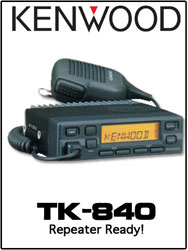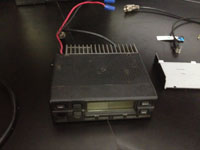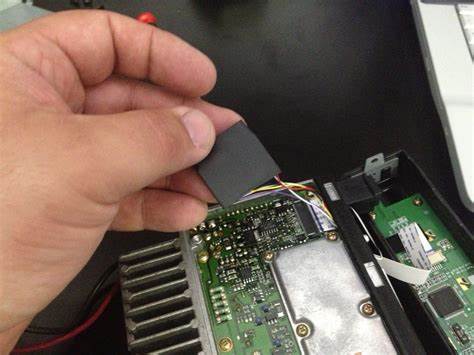Kenwood TK-840 UHF Mobile Radio Rating = 7/10
Buy one now here

I found the Kenwood TK-840 on eBay after a search for “GMRS Mobile” revealed this was a popular and inexpensive radio that has been mostly retired from public safety and commercial service since the implementation of narrow band requirements. Fortunately for Amateur Radio and GMRS, this isn’t a concern and these older wide band radios still work great. I’ve purchased 7 of these now and I’ll share with you some of my thoughts on these wonderful tiny 25 watt mobiles from Kenwood.
First, I’m not a radio expert, and my enthusiasm is largely fueled by my lack of experience in radio, so simple, and reliable are my favorite two words right now. The TK-840 fits the bill. This is a very small radio, so small that I was surprised when the first one arrived on the UPS truck. The radio is barely 6 inches by 6 inches and about 2 inches tall, in fact the commercial Kenwood mic dwarfed the actual radio. This is perfect for fitting this into small SUV’s Trucks, and even a small car where space is limited.
After some serious research online I located the KPG-25D Software needed to program the radio, and ordered a USB programming cable for it as well. The software is very simple DOS based, and easy to figure out. Since this radio is capable of trunking as well as conventional operation, be sure to choose “conventional” when programming. Also choosing the SP programming option allows programming from 403 to 512 Mhz ensures that you can monitor (or transmit if you have an amateur license) local UHF HAM Repeaters in the area as well. The scan features tend to stump some people but it’s very simple once you understand how it works. In Conventional Mode, the 840 uses 32 systems with 250 groups in each system. This is a little strange until you see this, but essentially there are 32 systems with 250 channels within each system that allows you to program up to 8000 different frequencies into the radio, and scan 32 frequencies at a time, scanning one channel in each of the 32 systems at a time. So picture your systems are labeled 1-32. Then inside each system you name each frequency A-Z. You can go to system 1 and choose group (or frequency D) then go to system 2 and choose group B, then choose system 3 and choose group A and so on and so on. Whichever channel you choose within each system will no be in your “Scan List”. Confused? Maybe I’ll shoot some video soon and clear it all up. There are two great things about this, first the 840 scans really fast, and second the 840 has many options for reverting to the last frequency, or your last frequency choice when you take the mic off hook. This radio truly gives you the ability to grab the mic and respond to traffic even if it came in on a frequency you weren’t originally on, but picked it up in scan. Great features.

25 Watts. More than enough in most cases and with a high gain antenna it’s even better. The audio is perfect as you would expect from a commercial radio, and the volume is loud enough for most noisy windows down situations even on the highway.
The key here is really to learn the software when you program your TK-840. There are so many features in this tiny radio that even with the out dated DOS programming, it’s still simple to tailer it to your needs with features like off the hook scanning if you wish, channel lock out using the “aux” button when you need to lock a frequency out of your scan list temporarily. and even minimum volume settings so you never turn it down too far and miss traffic.
As for durability all I can say is that some of the radios I picked up are very well used showing visible signs of some pretty serious equipment trauma. I’m picturing work boots, tools, and who knows what else beating these things for many years in a truck cab, or police car, but all of them work as well as I suspect they did when new. That’s impressive. I also like the off white commercial Kenwood Mic’s that came with all of them. These mic’s are substantial and sound just great. No complaints there.
UHF Connectors and power cables were all that came out of the back of these units, so I had to source the rest of the power harnesses, and solder them on. I would recommend finding some newer Kenwood power cables, mounting brackets and make sure your mic clip is grounded for your scan features to work properly between on and off hook scanning.
Now here’s some of the only issues I experienced with buying these radios used.

There is no guarantee that someone didn’t cut the antenna or power cables clear off the radio when pulling these from trucks or police cars etc... I found both problems in a batch of 5 I purchased. Some patients, and a good soldering pen solved this.
Three of the 840’s I bought transmitted an awful screeching data tone after the end of transmitting. I’m familiar with the Motorola MDC 1200 and Kenwood FleetSync PTT ID sounds, but this was more harsh and at first worried me that something was very wrong with these radios. After searching online for many hours my wild goose chase led me to a few companies that showed the 840 was capable of having special PTT ID boards installed in them.  I also determined that it was likely this was a GE-Star sound, and then stumbled upon this link and confirmed it to be GE-Star. Perfect! I removed the case covers on one and got lucky finding a small dangling Cimarron CEU-1 PC board wrapped in shrink tubing and about 6 wires leading deeper into the radio. I then pulled off the face of the radio, then unscrewed another PC board and eventually found where the wires had been soldered onto that board. A little bravery and a pair of wire cutters and the problem was solved. I re-assembled the 840, plugged it in, and all was well, no longer transmitting the PTT ID in GE Star. The “surgery” went smooth on the other TK-840’s though one of them had the little Cimarron CEU-1 board hidden behind the faceplate. Clipped the 6 wires, and voila.
I also determined that it was likely this was a GE-Star sound, and then stumbled upon this link and confirmed it to be GE-Star. Perfect! I removed the case covers on one and got lucky finding a small dangling Cimarron CEU-1 PC board wrapped in shrink tubing and about 6 wires leading deeper into the radio. I then pulled off the face of the radio, then unscrewed another PC board and eventually found where the wires had been soldered onto that board. A little bravery and a pair of wire cutters and the problem was solved. I re-assembled the 840, plugged it in, and all was well, no longer transmitting the PTT ID in GE Star. The “surgery” went smooth on the other TK-840’s though one of them had the little Cimarron CEU-1 board hidden behind the faceplate. Clipped the 6 wires, and voila.
So, in the end I really like these radios. The price couldn’t be better, and they are little workhorses. I’m sure I can find higher powered UFH Mobiles (up to 110 Watts in some of the TK-890H’s etc...) but for GMRS this seems to fit the budget and sounds great with a very fast scan.
OregonGMRS.org



